

Palästina - Israel
home
  Palästina - Israel home |
|
Visiting Gaza a second time
May 12 to May 17, 2011 Peter Voss 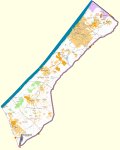 Gaza maps: 'OpenStreetMap' 'destruction'; 'no-go'; 'satellite': Google Earth or Google Maps, else (28 MB) Introduction 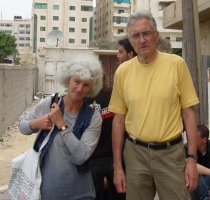 This
report will be quite different from my first report about the trip
almost exactly one year ago in May 2010. Originally I had planned
to continue last year's trip, but circumstances in Egypt were less
favorable for me this time and towards the end of April I had given up
hope of getting into Gaza this year. This
report will be quite different from my first report about the trip
almost exactly one year ago in May 2010. Originally I had planned
to continue last year's trip, but circumstances in Egypt were less
favorable for me this time and towards the end of April I had given up
hope of getting into Gaza this year.It was only two days later that the chance was offered to join the Convoglio Restiamo Umani (convoy stay human) that was going to commemorate Vittorio Arrigoni on May 15, one month after he was murdered. My fellow traveler Edith Lutz and I knew very little about the convoy when we arrived in Cairo on May 10. It was clear from the very beginning that any kind of group travel into Gaza would take place under completely different conditions compared to my individual trip the year before. The murder of Vittorio Arrigoni indicated that visitors from the outside were less secure. We thus had to be prepared to be always under tight supervision. Thus there was only a dim hope that there would be a chance to get away from the group, particularly when it meant going on a time-consuming excursion or to visit areas near the armistice line. There was indeed no chance for any of that. For both of us it was possible, though, to visit institutions or people when we were accompanied by what was considered to be a trustworthy person. The main events of the CO.R.UM. are recorded on the website www.vik2gaza. In this report I will only try to supply some additional information, some for the participants, who I believe due to the short time of our stay often did not know exactly where they were in Gaza, and some for the general public as a chronicle of events. The group itself was doing a lot of photo and video recording for the documentation, normally staying fairly close to the particular event. As is my habit anyway, I decided to stay in the background and try to give more of an overview. I had equipped myself with a better video camera as compared to last year and filming from the distance and extracting still pictures from the videos did indeed not pose a problem this time. The main purpose of this trip was to commemorate Vittorio Arrigoni and meet his friends in Gaza as well as the groups and institutions that he had worked with and which were commemorating his death in one way or another. I had met Vittorio twice, but not to the point that he would know who I was. I had email contact with him after my first trip and he wrote to me that he had actually seen me in Gaza. I had not been aware of the fact that he was there. We met the rest of the group on the evening of May 11 in Cairo. The group was made up of 90 % Italiens and the rest Internationals. Edith and I were the only Germans. May 12, 2011 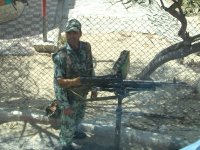 In the morning of May 12 we took off in
two busses, accompanied by
armed policemen in civilian clothes (Vik2Gaza-video, the only one left).
As we were approaching El Arish
the number of checkpoints increased. At the first checkpoint a number
of people took some photos, which didn't make the Egyptians exactly
happy.
I had thought that I had taken one secretly, but it obviously
did
not turn out that way. No
more photo taking of military installations from here on. Not far from
El Arish the convoy was stopped at one of the checkpoints and it took
more than two hours of intensive telephoning before we could continue
without further delay. In the morning of May 12 we took off in
two busses, accompanied by
armed policemen in civilian clothes (Vik2Gaza-video, the only one left).
As we were approaching El Arish
the number of checkpoints increased. At the first checkpoint a number
of people took some photos, which didn't make the Egyptians exactly
happy.
I had thought that I had taken one secretly, but it obviously
did
not turn out that way. No
more photo taking of military installations from here on. Not far from
El Arish the convoy was stopped at one of the checkpoints and it took
more than two hours of intensive telephoning before we could continue
without further delay. At the Rafah crossing we had to leave the busses, had our baggage checked and had our passports collected. They stayed in Egypt, apparently in order to make sure that the whole group would return on May 17. There are busses running between the Egyptian and the Palestian border stations. On the Palestinian side we entered other busses that took us to our quarter near the harbor in Gaza City. We all stayed in one apartment building. We were distributed over a number of flats, where we were provided with foam matresses, sheets and blankets. Most people had brought sleeping bags along. For me this setting was quite familiar from the time when I was helping during the olive harvest. After we had settled in, we went to a restaurant in town for the evening meal and afterwards to an outside restaurant, the 'Gallery' in order to relax and watch some movies. One of these movies was about Vittorio. We would usually end up at this restaurant in the evening. May 13, 2011 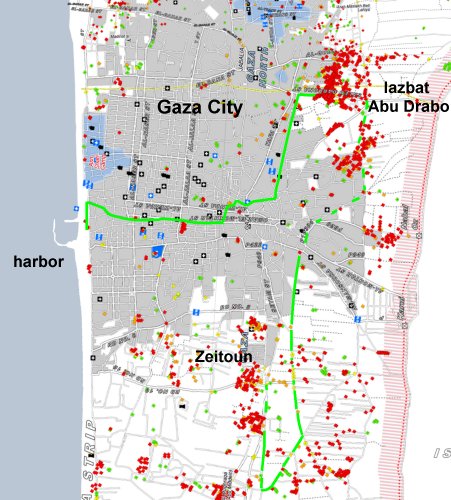 We
got on the busses and started out across Gaza City to Salah El Deen
street, followed that for a stretch towards Beit Hanoun and then
turned off into the village of Iazbat Abu Drabo
(Vik2Gaza, 'we
are getting to know Gaza').
As the map shows, this village was very heavily damaged. This is a map
put together from 5 maps published by the UN from satellite images.
Every red dot corresponds to a building destroyed during the Israeli
attack at the turn of the year 2008/2009, named 'Cast Lead'. If the
'Gaza Freedom March' had taken place in January of 2010, the village
would have been the starting point for the demonstration towards the
Erez crossing. The small demonstration that actually took place was
apparently much shorter, just long enough for a photo shooting. We
got on the busses and started out across Gaza City to Salah El Deen
street, followed that for a stretch towards Beit Hanoun and then
turned off into the village of Iazbat Abu Drabo
(Vik2Gaza, 'we
are getting to know Gaza').
As the map shows, this village was very heavily damaged. This is a map
put together from 5 maps published by the UN from satellite images.
Every red dot corresponds to a building destroyed during the Israeli
attack at the turn of the year 2008/2009, named 'Cast Lead'. If the
'Gaza Freedom March' had taken place in January of 2010, the village
would have been the starting point for the demonstration towards the
Erez crossing. The small demonstration that actually took place was
apparently much shorter, just long enough for a photo shooting.The area we travelled was not familiar to me, so I don't know exactly which way we went 'south' (actually 'south-west') from the village. Sooner or later we were on Wadi Al Arayes street until Al-Karama street (for road names see OpenStreetMaps). We followed that road and turned 'north' on Salah El Deen street until we reached Zeitoun, where we visited the al Samouni family. I have not figured out where exactly on the map these houses are located. It obviously has to be in one of the red dot groups. 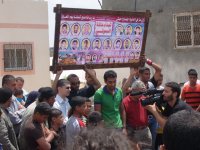 For this visit see Vik2Gaza (video,
photos).
The al Samouni family was lately in the news again in connection with
an
article by Richard
Goldstone in the Washington Post on April
1. The second
sentence in this article reads: "If
I had known then what I know now, the Goldstone Report would have been
a different document." and further down: "For example, the most serious
attack the Goldstone Report focused on was the killing of some 29
members of the al-Simouni family in their home. The shelling of the
home was apparently the consequence of an Israeli commander’s
erroneous interpretation of a drone image, and an Israeli officer is
under investigation for having ordered the attack. While the length of
this investigation is frustrating, it appears that an appropriate
process is underway, and I am confident that if the officer is found to
have been negligent, Israel will respond accordingly. The purpose of
these investigations, as I have always said, is to ensure
accountability for improper actions, not to second-guess, with the
benefit of hindsight, commanders making difficult battlefield decisions." For this visit see Vik2Gaza (video,
photos).
The al Samouni family was lately in the news again in connection with
an
article by Richard
Goldstone in the Washington Post on April
1. The second
sentence in this article reads: "If
I had known then what I know now, the Goldstone Report would have been
a different document." and further down: "For example, the most serious
attack the Goldstone Report focused on was the killing of some 29
members of the al-Simouni family in their home. The shelling of the
home was apparently the consequence of an Israeli commander’s
erroneous interpretation of a drone image, and an Israeli officer is
under investigation for having ordered the attack. While the length of
this investigation is frustrating, it appears that an appropriate
process is underway, and I am confident that if the officer is found to
have been negligent, Israel will respond accordingly. The purpose of
these investigations, as I have always said, is to ensure
accountability for improper actions, not to second-guess, with the
benefit of hindsight, commanders making difficult battlefield decisions."Everybody wondered how he came to this conclusion, because there is apparently no new evidence. 
 The busses then drove us through town
not far from the coast along al Naser street until we reached the
'northern' end of town, where they turned towards the coast near al
Andalos Tower, the highest building in Gaza that apparently was used
for target practice during operation 'Cast Lead'. Closer to the coast
we continued further 'north' and passed the site where the
American School (El Americia School) used to be, which was also
attacked
during 'Cast Lead'. The busses then drove us through town
not far from the coast along al Naser street until we reached the
'northern' end of town, where they turned towards the coast near al
Andalos Tower, the highest building in Gaza that apparently was used
for target practice during operation 'Cast Lead'. Closer to the coast
we continued further 'north' and passed the site where the
American School (El Americia School) used to be, which was also
attacked
during 'Cast Lead'.We drove past the harbor to a beach restaurant for lunch. The restaurant was one of the many wedding restaurants along the beach and for that purpose had an impressive stage decoration. After lunch it sounded as if the group would be allowed to go down to the beach. Some people apparently made it down there. It was not very far. But by the time I had found my way everybody was chased back by the security people and the beach was left to the donkeys. 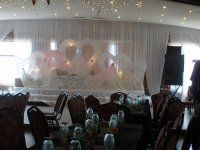
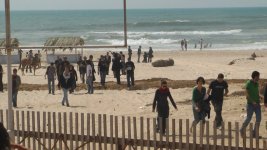  The rest of the day we spent in the 'Gallery'. There were some smaller meetings that I did not attend. Instead I met with some of the people I had become aquainted with during my stay the year before, like Dr. Alaa and his wife who is a piano teacher. I had only met them briefly the year before. To my surprise he was one the main carers for our group . Furthermore I met Dr. Schokry from the Islamic University and Alaa Sade Saed, my private taxi driver then. Unfortunately during all these days I was not able to meet everybody I had wanted to see because of conflicting time schedules. May 14, 2011 This morning we walked the short distance to the harbor were we wanted to see the boat Oliva. The Oliva boat was a project of Vittorio and the International Solidarity Movement (ISM), intended to accompany the fishermen on their way out to sea and to set a clearly visible sign for the Israeli Navy that there was international observation. This morning we met a delegation of the fishermen and had a first look at the boat (Vik2Gaza report, video, photos). We were to return on May 15, one month after Vittorio was murdered, in order to commemorate his death. Edith Lutz who eight months earlier had been on the Jewish boat 'Irene' trying to reach Gaza, brought a collage of the boat (Vik2Gaza report). From the harbor the busses took us to the Square of the Unknown Soldier, where a demonstration took place on the eve of Nakba Day. 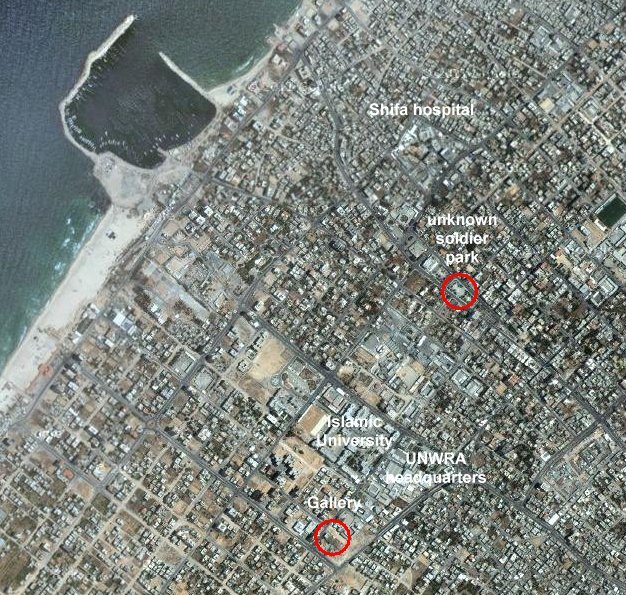 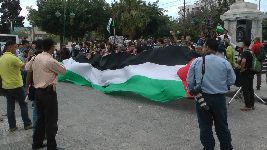 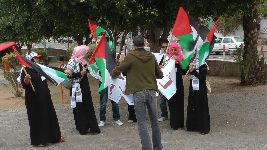 We continued to the Shifa Hospital (Vik2Gaza report, video1, video2). After a reception meeting we started with a visit of the hospital, but it turned out that we plus our Palestinian companions were just too many people for that. Therefore only a few continued. 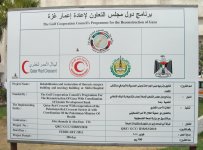 We went on to the next station which was the Jabalia Sports Center (Vik2Gaza report) 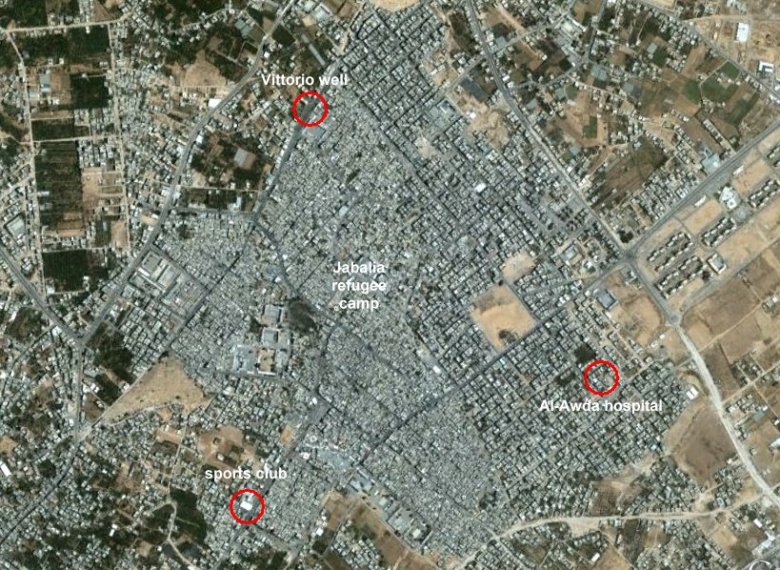 Among other activities there was a football game that took place between a Palestinian and an Italian team. For the Palestinians it probably was a bit surprising that a girl played on the Italian team. From here we went to the last visit during this day, to the Al Wahda Hospital (Vik2Gaza report). Here they did not try to show all of us the hospital. Most of us stayed in the small park in front. The rest of the day we spent again at the Gallery, where we could check and write our emails and relax. The media team always prepared their daily report there. May 15, 2011 May 15 was Nakba day. The participation with the Nakba demonstration was planned for later in the morning. Before that the murder of Vittorio was to be commemorated at the harbor (vik2gaza) and also a visit at the fishermen's cooperative was planned . We started later than planned and there was some confusion this morning because the possibility for another activity had come up for noon which collided with the schedule for the demonstration. Much of what was discussed this morning went past me. From the way the day developed it became clear that the group preferred to stay with the demonstration, but it also seemed to me that our security people were determined to have us demonstrate totally separated from the main demonstration. During the demonstration we were restricted in our possibility to move in such a closely packed way that it became rather uncomfortable. 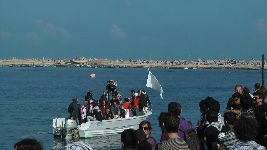
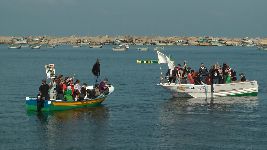 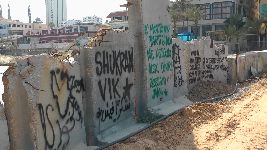 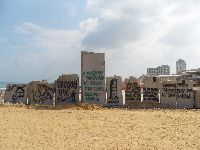 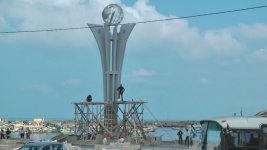 At the entrance of the harbor a monument was under construction. This was to become a memorial for the nine passengers of the Mavi Marmara killed by the Israeli Navy a year ago. The memorial was unveiled on May 31, 2011. 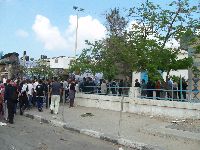
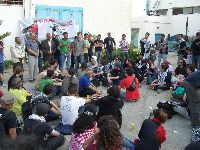 The demonstration took place on Salah El Deen street along part of the stretch along which the Gaza Freedom March was planned originally. 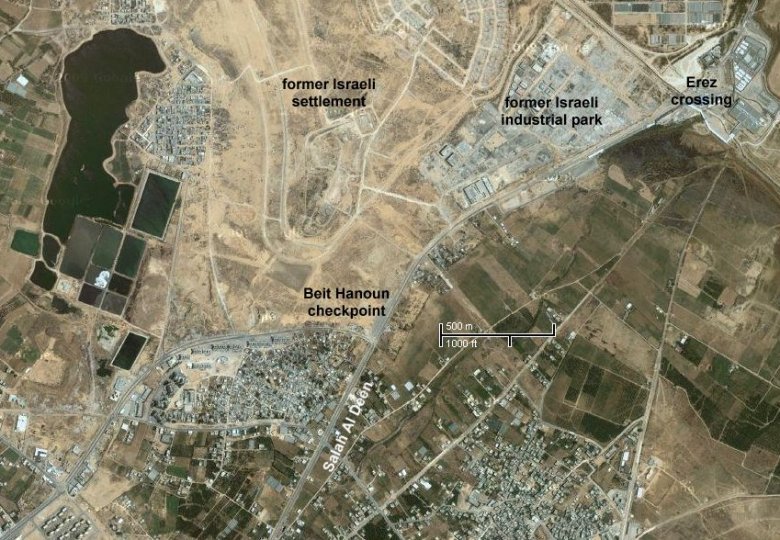 The main demonstration apparently started around 11 o'clock and ended about half an hour later. We arrived at around 11:50 and marched a relatively short stretch up to the Beit Hanoun checkpoint. The main demonstration had marched through this checkpoint close to the Erez checkpoint apparently for the first time on Nakba Day (but, as I was told, not on other days). One participant claimed that the front went as close as 100 m to this checkpoint. From videos (v1, v2) in the internet it seems to be more like 300 m, i.e. to the white roof visible on the satellite map along the road south of the letters 'rk' in 'park'. The videos document the sniper shooting and the injured demonstrators, one of them was hit in his abdomen. In our demonstration we had to form groups of three with one Palestinian of the group accompanying us taking the responsibility. The three of us in my group had a guardian angel. She was very concerned about me, because I did some video shooting and therefore did not march properly. I was her 'baby' and supervising this baby must have been rather strenuous, because at the end of the demonstration she was pretty exhausted. Filming was difficult for me because we were located at the very end and the big banner in front and several large flags were blocking my view. The filmer of the youtube-video v2 was apparently travelling on one of our busses, but did not have the restrictions we had. His video gives an impression of how things looked in front of us. In the beginning of our march we had quite an audience: the people walking in the opposite direction on their way home. But later the road emptied and just a few cars tried to push through our demonstration or we had to try to get past cars standing in the way. It took about an hour before we reached the Beit Hanoun checkpoint. The security people agreed that a small number of us would be allowed through the checkpoint in order to climb the hill next to it where they should have had a view of the Erez checkpoint. I don't know whether any of the video filmers and photographers went along. The rest waited and watched the ambulances racing by. As I was told later, two people were killed near Erez, one 17 year old boy and a journalist. Sixty more had shot wounds. Ten of them were severely injured. All these demonstrators were located on the road to Erez, on Palestinian territory, possibly armed with Palestinian flags, not anywhere near the armistice line. 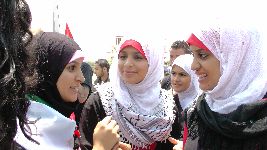 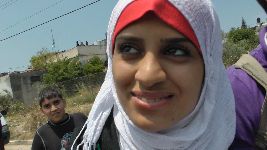 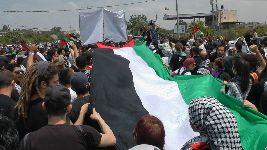  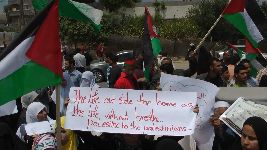 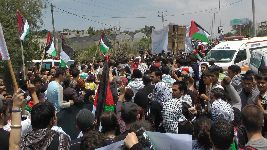 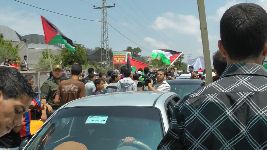 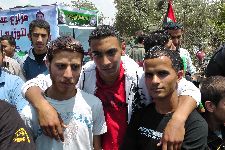 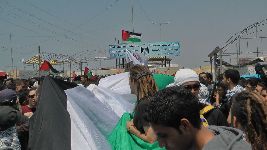 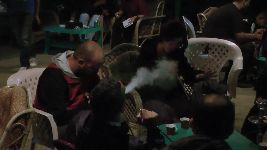 Later we retreated to a tent that provided some shade, but where we were hammered with music instead. By the time we entered our busses it was 15 o'clock. Edith Lutz and I had an invitation for the evening meal at Dr. Schokry's house. May 16, 2011 This day was packed with activities and therefore it was the day that our usual much delayed start really became a nuisance, because there were some exact times for meetings to be met and hence we had to rush at some places. The group was subdivided this morning. I went with the bus
that went to a house near the no-go zone close to the town of Khuzaa
(see my
report from last year and The
Armistice Line on the topic of machine gun towers), where Vittorio had
often helped the family
living there and evidently had become a close friend of theirs (vik2gaza report
and video).
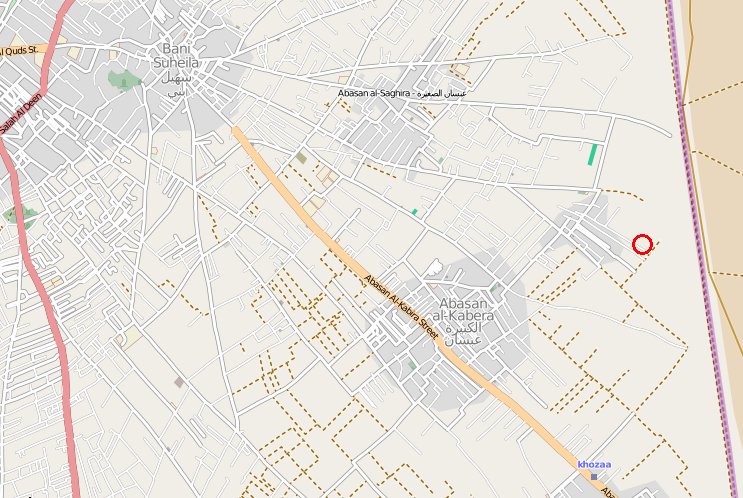 OpenStreetMap
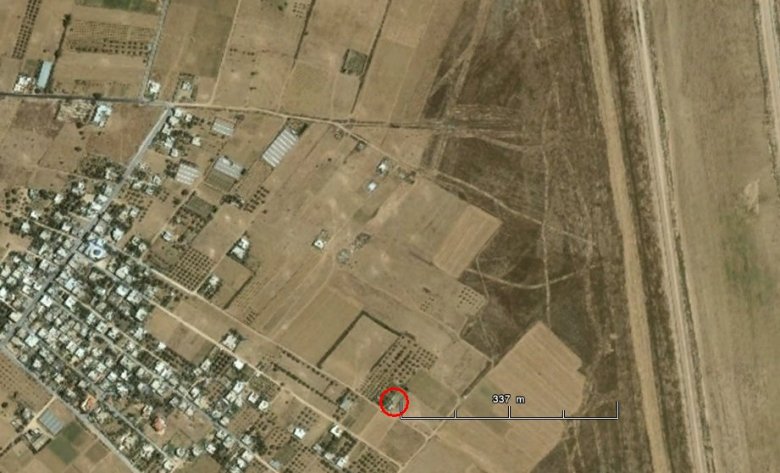 Google, June 2007
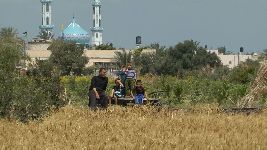
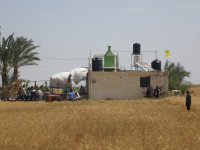 spectators the farm house
We were rushed back to the bus. It seems to me that many participants did not figure out where the no-go zone actually was. I took a quick shot of the tower and the fence in the distance. The tower looked a bit different from the machine gun towers that I had seen last year. A film team that left the premises last told me that they filmed a tank driving along the fence (see vik2gaza-video). There was also talk about a symbolic grave that the farmer's family had erected for Vittorio but which was not shown explicitly to the group. Very likely it was the structure in the photo below. 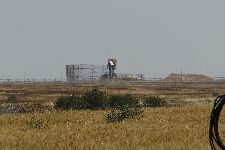
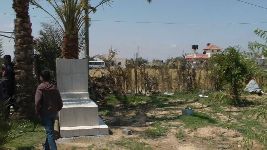 weapon's tower about 1 km away symbolic grave We then went to the Village Improvement Center in Khuzaa (vik2gaza report, video) 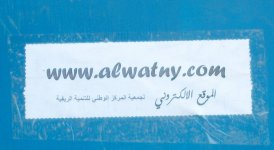
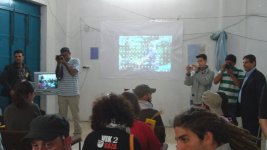 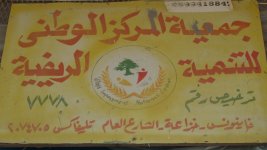
From there we went to the Al Aqsa university near Khan Younis which is located in an area outside the city that was formerly occupied by an Israeli settlement. This is apparently the only area where the settlers did not destroy everything when they left. We had a big reception and a short tour of the campus. 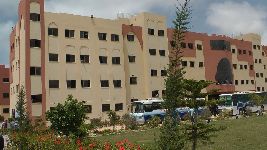 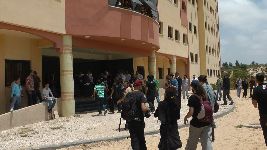 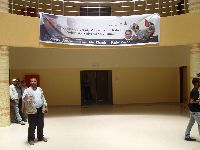 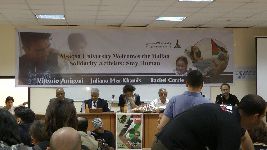  The group had to be reshuffled again because subgroups were taking off in different directions. I went along with the people that wanted to see the place where the 'Vittorio well' in Jabalia was to be built (see satellite map May 14). First we had a reception at the Jabalia-Al Nazih municipality and then we went over to the location of the well, which is to supply water for the Jabalia inhabitants (on the water problem of Gaza see e.g. 'preparation for the Gaza Freedom March (April 2009)' and Rebhy A. El Sheikh, 'water situation in Gaza', video and text). 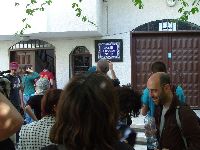
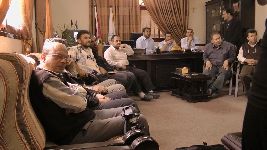  
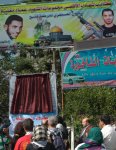 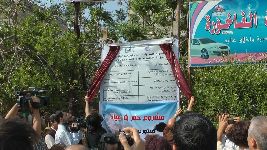 Al Fakoura School Vittorio well
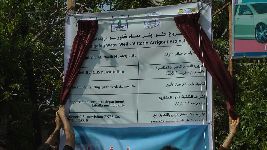 Back to the 'Gallery' where a good-bye party was taking place in the evening. As far as I could see this consisted mainly of a concert with various music groups. Some people had a good time in front of the stage or when dancing under a tent roof to the side and there was also a rather late but elaborate supper. 
Two local pipe smokers and one visiting one 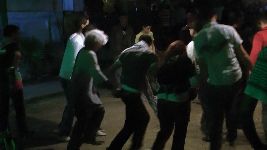  Edith Lutz dancing along Evening concert May 17, 2011 It was time to say good-bye. It was an overcast day. I had a last look out of our apartment window at the harbor.  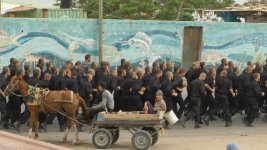 Two groups of recruits were jogging past. We were to leave after noon, but it took Dr. Schokry quite some time before our security man would allow me to go along to the Islamic University in the morning - and only for 45 minutes. 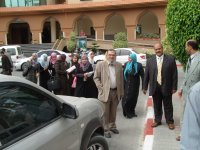  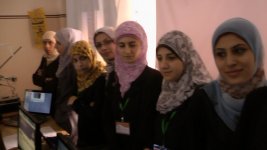 Professors Dr. Afifi, Dr. Jendia, Dr. Schokry and engineering students professors Dr.
Schokry and Dr. Afifi
engineering
students exhibiting their final exam projects
We got onto the busses shortly after noon.The guardian angel waved good-bye and we took off along the coastal road so familiar to me. I caught a quick look of the "recreation clinic". Construction had continued and a tile roof had been replaced by a glass dome. 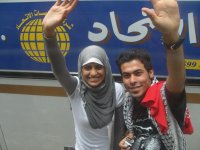  We crossed over to the Egyptian terminal. I was surprised because one the Egyptian border officers recognized me after one year, which may indicate that my border experience then may have been something unusual for the Egyptians too. There was somebody else who recognized me: the boy who had carried my bicycle the year before. We continued on Egyptian busses. This time I was travelling in the first bus and therefore noticed that for the next six hours until we reached the Suez Canal we were accompanied by a pickup truck carrying five policemen with Kalashnikovs. One of them did not mind being photographed. 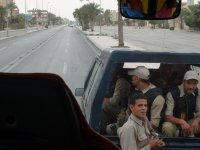 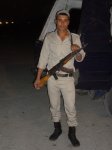 We arrived at our Cairo hotel after 1 o'clock in the morning. The group gathered in the restaurant in order to exchange photo and video files. Everybody had to get up early the next morning in order to catch the flight going home. The older people said good-bye and went to bed to get some sleep. The younger ones stayed up through the night and to judge from the noise level seemed to have had a good time. 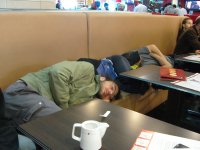
At the airport a last occasion to say good-bye. |